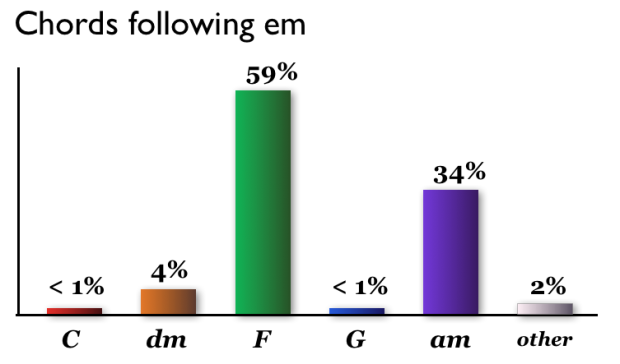Hooktheory, a system for learning to write music, analyzed 1,300 popular songs for how chords were used. The above shows chords that followed an E minor chord.
This result is striking. If you write a song in C with an E minor in it, you should probably think very hard if you want to put a chord that is anything other than an A minor chord or an F major chord. For the songs in the database, 93% of the time one of these two chords came next.
The most common chords used overall were G, F, and C.
[via Waxy]
Update: See also this great musical sketch by Axis of Awesome in which they sing some 40 songs that use the same four chords. [Thanks, Jan]


 Visualize This: The FlowingData Guide to Design, Visualization, and Statistics (2nd Edition)
Visualize This: The FlowingData Guide to Design, Visualization, and Statistics (2nd Edition)

I would have expected Em Am and B to have the highest ranking, as these are the typical basic guitar chords.
Also, there is also an amazingly popular chord progression used in many many popular songs: http://www.youtube.com/watch?v=5pidokakU4I&feature=youtube_gdata_player
I passed this on to a musician friend, and this is what they had to say:
Interesting. I sat down at the piano, and immediately jim croce’s song “I had to say I love you with a song” came to the fingertips…which has a Dminor following the Emin.
Tried the other ones, and they “make sense” but they wouldn’t be “interesting” enough for me to consider. Hence, me not really writing pop tunes.
On a technical note, I’m surprised that the Dminor came in so low, simply because it is super related to F major (2 out of 3 notes are the same) so you’d think it would be more used. Also, D minor is a bit easier to play on guitar than F major.
Hmmm, well, there ya go!
That`s probably why A LOT of pop songs all sound the same…
Think very hard? As is, eschew originality?
As a musician myself, there’s a very logical explanation for these relationships. Most rock and pop songs are based on blues chords that use a standard progression: the one, four and five of a scale. [This is not rocket science to figure out: I count on my knuckles as a mnemonic device. Start with the main note of the progression, add a letter to every knuckle. The last two knuckles are the 4 and 5.]
If E is the main note of the progression, the four is A.
In the key of B, E is the four of the progression, so F is the five.
In the key of A, E is the five so D is the four.
In the distribution above, F, D and A account for 96 to 97% of the observations. So one interpretation of the data: 96 to 97% of pop songs are based on a one-four-five chord progression.
I find the results of this very surprising. For literally EVERY blues song ever written, the IV (A) will follow the E chord. Furthermore, F is not the IV or the V in the most common keys (C maj and G maj).
I’m running through as many songs as I can in my head and I can think of very few examples of going from Emin to Fmaj. It’s a strange interval. There are many examples of going from Emajor to Fmajor (think Spanishy style chord progression).
In my musical experience A or G follow Emin way more often than F.
I’d guess that something 80% of pop songs in the post-standards, pre-Beatles era used one of two chord progressions: standard 12-bar blues or I-vi-IV-V.
Wow, so computer aided researchers will be writing hit songs how soon now?!
Band-in-a-Box will crank out original jazz changes, melodies and solos as fast as you can click a mouse button.
They all sound coherent, but not inspiring or original.
It is very obvious to me that the “musicians” on here are completely clueless:
D minor is not just “super related” – it is the enharmonic equivalent
In the key of B, the V chord is F# – there is no whole step between E and F
And F is in fact the IV chord in one of “the most common keys” mentioned – C major
And this is why we apparently need mathematical analysis and computer software to generate music these days.
when musician, these relationships are obvious. Overall for traditional music.
I think another kind of visualization as networks could have been nice.
Also, It would be nice to map the relaionships between chords in Jazz through time, from the early times of bebop to more contemporary jazz like coltrane’s, david liebman’s
Instead of mapping chords, we could instead map the intervals between them: tritone, whole-tone, also the succession of chord quality: a dominant following a minor chord, semi-diminished and minor.
Apart from harmony, rhythm could also be visualized some way.
Juste some more ideas. Maybe someday, I’ll try to map this out and let you know when it’s done.
In the key of B, E is the four of the progression, so F is the five
No
The fifth is F# for the key of B.